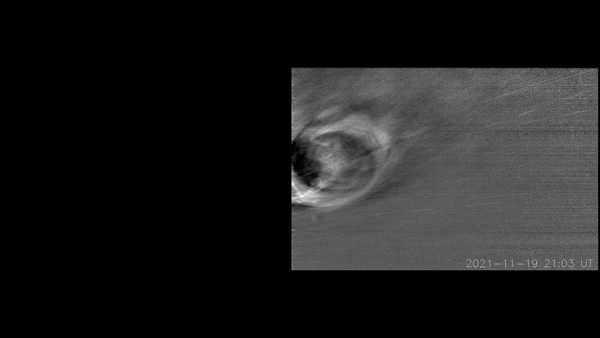
Every so often, the sun's simmering magnetic field burps colossal clouds of plasma out into the space beyond. These are called coronal mass ejections (CMEs). If one CME strikes Earth, for example, the result can be spectacular auroras — and, just-as-spectacular disruptions of electrical grids and satellites.
Now, NASA's Parker Solar Probe has gotten a first-ever peek inside a CME as it erupted from the sun. And what lies inside appears to be a treasure trove for solar physicists. The probe's visible-light-detecting, Wide-field Imager for Parker Solar Probe (WISPR) instrument caught clear, turbulent eddies within the CME.
The eddies are what physicists call Kelvin-Helmholtz instabilities (KHI). Physicists think KHI events occur whenever one patch of fast-moving fluid interacts with another. On Earth, KHI occurs in clouds when the wind speed at one end of the cloud is different from that at the other end.
Related: NASA's Parker Solar Probe smashes record for fastest human-made object
Solar physicists have inferred that KHI exist in CMEs, as plasma in a CME moves at odds with the background solar wind. But they have never had the proper equipment, in the proper place, to observe the phenomena.
"The turbulence that gives rise to KHI plays a fundamental role in regulating the dynamics of CMEs flowing through the ambient solar wind," said Evangelos Paouris, a solar physicist at George Mason University, in a statement. "Hence, understanding turbulence is key in achieving a deeper understanding of CME evolution and kinematics."
The Parker Solar Probe launched on Aug. 12, 2018. Since then, the probe's elliptical orbit has allowed it to enter the sun's corona closer than ever before — in essence, becoming the first human-made object to enter the sun's outer atmosphere, just 11.5 solar radii from the sun's surface.
Get the Space.com Newsletter
Breaking space news, the latest updates on rocket launches, skywatching events and more!
And, even now, Parker Solar Probe has not entered its final orbit. The probe has repeatedly flown past Venus in order to use the planet's gravity to boost its speed and tighten its orbit around the sun. In November of this year, the probe will fly past Venus a seventh time, tightening its loop about the sun yet again — allowing it to pass within just 9.5 solar radii from the sun in 2025 and beyond.
Join our Space Forums to keep talking space on the latest missions, night sky and more! And if you have a news tip, correction or comment, let us know at: community@space.com.

Rahul Rao is a graduate of New York University's SHERP and a freelance science writer, regularly covering physics, space, and infrastructure. His work has appeared in Gizmodo, Popular Science, Inverse, IEEE Spectrum, and Continuum. He enjoys riding trains for fun, and he has seen every surviving episode of Doctor Who. He holds a masters degree in science writing from New York University's Science, Health and Environmental Reporting Program (SHERP) and earned a bachelors degree from Vanderbilt University, where he studied English and physics.
-
DrRaviSharma It is amazing Probe!Reply
We have multiple space assets such as Parker Probe, European probes and finally Aditya L1 that can help us study Distribution and LEO and Radiation belts related effects of CME.
As some papers were published by NASA Goddard Center and Institute at NY,, what is required is constant updates through enriching open databases with such additional real-time data, similar to what the LHC type updates provide for particle Physics.
Not only for Space Weather and protection of Space Assets, these will also help manage the grids and power distribution on Earth.
Ravi
(Dr. Ravi Sharma, Ph.D. USA)
NASA Apollo Achievement Award
ISRO Distinguished Service Awards
Former MTS NASA HQ MSEB Apollo
Former Scientific Secretary ISRO HQ
Ontolog Board of Trustees
Particle and Space Physics
Senior Enterprise Architect
SAE Fuel Cell Tech Committee voting member for 20 years.
http://www.linkedin.com/in/drravisharma









